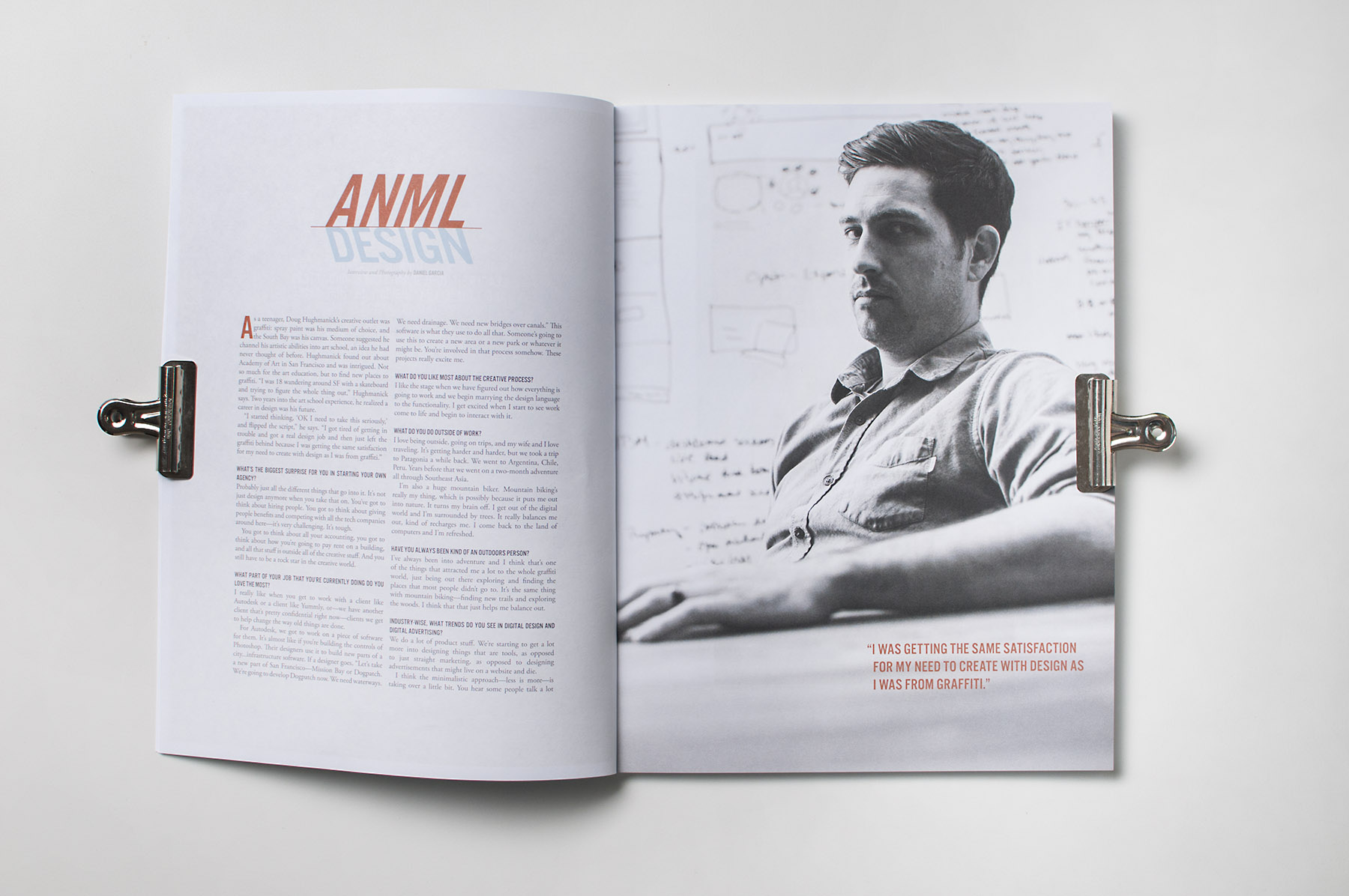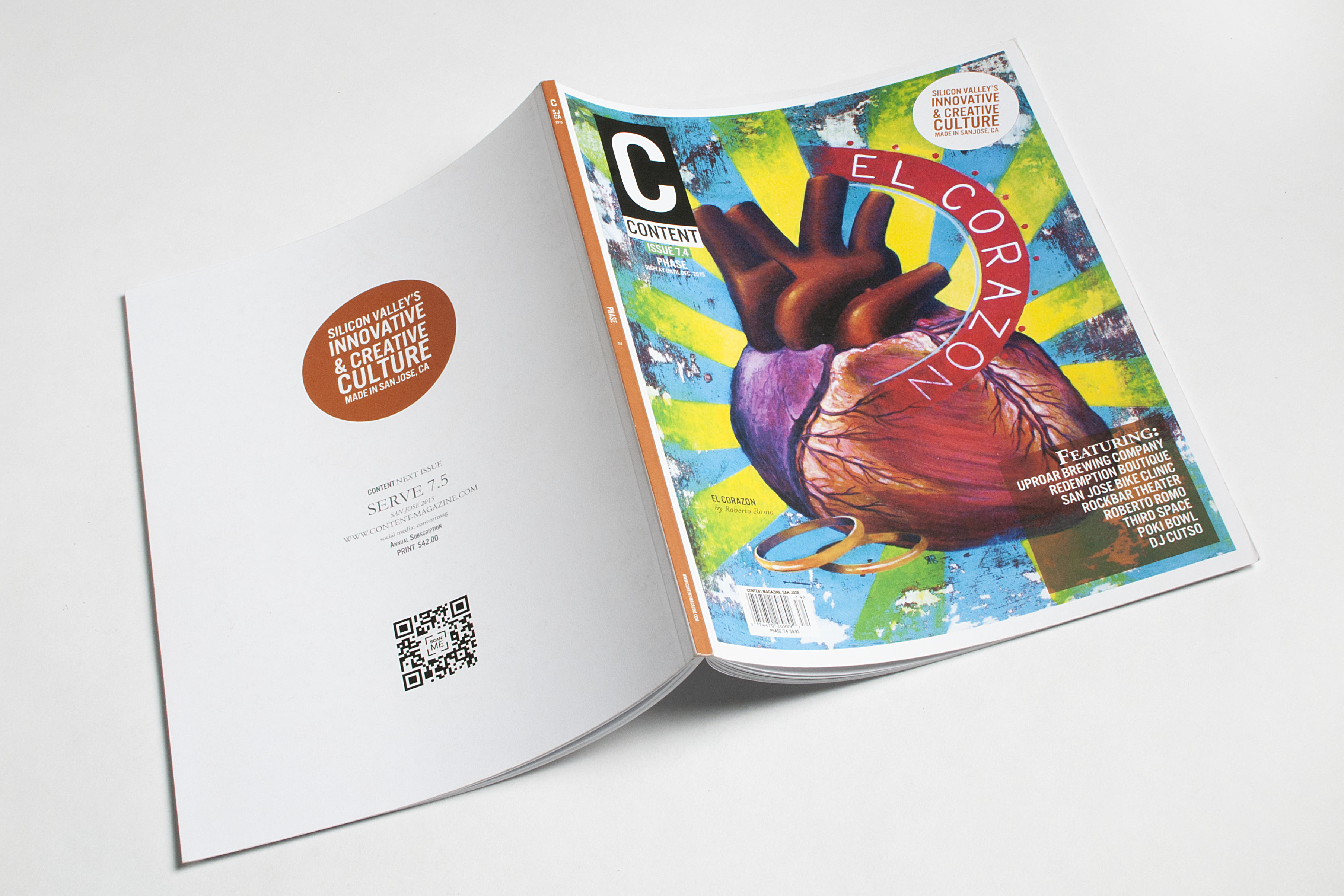
As a teenager, Doug Hughmanick’s creative outlet was graffiti: spray paint was his medium of choice, and the South Bay was his canvas. Someone suggested he channel his artistic abilities into art school, an idea he had never thought of before. Hughmanick found out about Academy of Art in San Francisco and was intrigued. Not so much for the art education, but to find new places to graffiti. “I was 18 wandering around SF with a skateboard and trying to figure the whole thing out,” Hughmanick says. Two years into the art school experience, he realized a career in design was his future.
“I started thinking, ‘OK I need to take this seriously,’ and flipped the script,” he says. “I got tired of getting in trouble and got a real design job and then just left the graffiti behind because I was getting the same satisfaction for my need to create with design as I was from graffiti.”
What’s the biggest surprise for you in starting your own agency?
Probably just all the different things that go into it. It’s not just design anymore when you take that on. You’ve got to think about hiring people. You got to think about giving people benefits and competing with all the tech companies around here—it’s very challenging. It’s tough.
You got to think about all your accounting, you got to think about how you’re going to pay rent on a building, and all that stuff is outside all of the creative stuff. And you still have to be a rock star in the creative world.
What part of your job that you’re currently doing do you love the most?
I really like when you get to work with a client like Autodesk or a client like Yummly, or—we have another client that’s pretty confidential right now—clients we get to help change the way old things are done.
For Autodesk, we got to work on a piece of software for them. It’s almost like if you’re building the controls of Photoshop. Their designers use it to build new parts of a city…infrastructure software. If a designer goes, “Let’s take a new part of San Francisco—Mission Bay or Dogpatch. We’re going to develop Dogpatch now. We need waterways. We need drainage. We need new bridges over canals.” This software is what they use to do all that. Someone’s going to use this to create a new area or a new park or whatever it might be. You’re involved in that process somehow. These projects really excite me.
What do you like most about the creative process?
I like the stage when we have figured out how everything is going to work and we begin marrying the design language to the functionality. I get excited when I start to see work come to life and begin to interact with it.
What do you do outside of work?
I love being outside, going on trips, and my wife and I love traveling. It’s getting harder and harder, but we took a trip to Patagonia a while back. We went to Argentina, Chile, Peru. Years before that we went on a two-month adventure all through Southeast Asia.
I’m also a huge mountain biker. Mountain biking’s really my thing, which is possibly because it puts me out into nature. It turns my brain off. I get out of the digital world and I’m surrounded by trees. It really balances me out, kind of recharges me. I come back to the land of computers and I’m refreshed.
Have you always been kind of an outdoors person?
I’ve always been into adventure and I think that’s one of the things that attracted me a lot to the whole graffiti world, just being out there exploring and finding the places that most people didn’t go to. It’s the same thing with mountain biking—finding new trails and exploring the woods. I think that that just helps me balance out.
Industry-wise, what trends do you see in digital design and digital advertising?
We do a lot of product stuff. We’re starting to get a lot more into designing things that are tools, as opposed to just straight marketing, as opposed to designing advertisements that might live on a website and die.
I think the minimalistic approach—less is more—is taking over a little bit. You hear some people talk a lot about having a lot less choices in interface design and making it very simplistic and guiding people through experiences. I think that is definitely a trend that I’ve been noticing happen: just a lot more simplicity.
How has being a designer changed your view of humanity? The way you look at things.
I look at everything as a user experience. It changes your thinking. You go into Philz Coffee, for example. I’m like, “I don’t know what the fuck I’m supposed to do. I’m standing at the counter. There’s a guy over here, there’s people over here. Who’s in line? Where do I pay?”
I walk up to the register. I’m like, “What happens if nobody pays?” He goes, “I don’t know. If it happens, we’re not going to worry about it.” Just things like that. You start thinking, “How can this be better designed to make this more clear?” You start looking at the physical world in user experience terms.
Was that already in your personality, you think, to problem‑solve? As you went from graffiti into design, then is your brain now thinking that way, or did you already have that….
No, it started with doing this interaction design. Before, it was all quick fixers. “Let’s make it look awesome,” all sorts of that. You get so caught up in that, you don’t think about if it’s the best way for it to work.
Think about your audience, don’t just design for yourself. Be willing to think, who is viewing this piece? Who’s using it? Because it could look beautiful, but if it doesn’t work, all you’ve got is a pretty picture.
I think that happened along the way when people started to question my work. They’re like, “How does it work? It doesn’t make sense.” I’m like, “But it looks cool.” They’re like, “If you just did this, it’d be so much easier.” I’m like, “No, I really like that little button I put right there. It’s shiny and it’s cool.”
Some people are siloed, like I only design user experience and I only do visual design, but I don’t feel like that creates the best end product. You need to consider both.
What is the most challenging thing for you on the creative side at this particular point?
Probably the most challenging part of it is staying fresh. You always have to stay ahead of the game. You always have to think into the future.
Is that as far as the tools that you’re using? Design trends?
The look. Yeah, flat design is super-trendy right now. What’s next? I don’t want to do just a flat design anymore, because if everybody’s doing that, how do you stay ahead of the pack? That’s always the challenge. You’ve got to stay on your toes.
Article originally appeared in Issue 7.4 “Phase”

